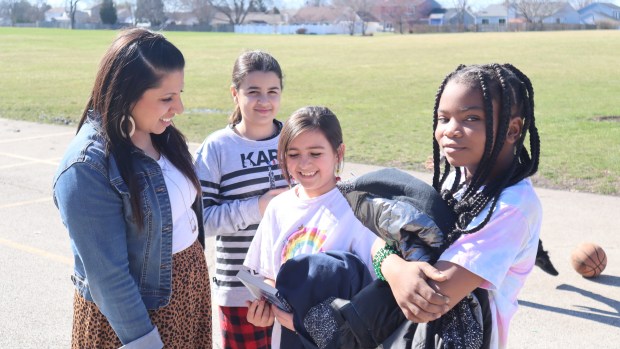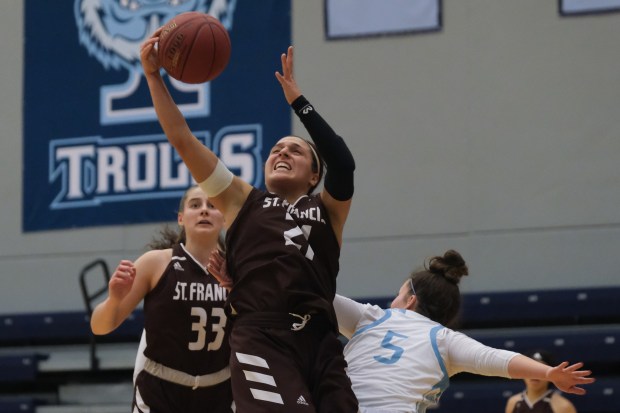Illinois’ 2024 Far West Suburbs Regional Teacher of the Year was once a young girl with an uncommon mixed heritage, Russian Jewish and Indian Hindu, searching for belonging in the educational system.
Now as a fifth-grade teacher at Georgetown Elementary School in Aurora and with a Ph.D. in education, Rachael Mahmood is encouraging everyone to bring their full, authentic selves to school. Whether it’s teachers, students or parents, she said they all should find strength in their unique identities.
“If we look at our identity as strengths, as funds of knowledge, as something that can be utilized, when we unite all of these identities together, we can definitely reimagine an educational system that serves everyone,” Mahmood said.
With her Regional Teacher of the Year award from the Illinois State Board of Education, which was announced in February, Mahmood now has the chance to share her message of inclusion and belonging on a bigger stage. That award placed her in the running to be the statewide Teacher of the Year.
The winner of the Illinois State Board of Education Teacher of the Year award is given a year-long paid sabbatical to tour the state as an ambassador for teachers, according to the state board’s news release announcing the finalists.
According to a state board spokesperson, the announcement on the winner of the award is set to take place later this month.
Teachers are selected to be a part of the Illinois Teachers of the Year Cohort, which includes regional and specialized teachers of the year, because they have “greatly improved their school communities and the teaching profession,” according to an infographic about the application process.
“Beyond being lifelong learners, these teachers are trend-setters, implementing best-practices, piloting new and innovative classroom strategies and inspiring other teachers within and beyond their school communities,” reads the infographic, which can be found on the Illinois State Board of Education website.
In the classroom, Mahmood is embracing the identities of her students in her curriculum and instructional techniques. She said this allows her students to better connect with the material and learn in a way that plays to their strengths.
For example, Mahmood said she has a lot of oral learners in her classroom. These students may be seen by some teachers as off-task or a problem, but actually, these students are just engaging in a different way, she explained.
“They are processing their learning through talking, but then sometimes we’re shutting them down because they’re not raising their hand or they’re not waiting for their turn,” Mahmood said.
When teachers learn about how different cultures communicate, she said they can use those cultural behaviors to help their students learn more naturally.
Mahmood said she also prioritizes her students’ “sensory needs” over traditional ways of managing a classroom. For example, she lets students be flexible about where they sit, shout out observations they have and even play with fidget toys at their desks.
While these students may not seem engaged in a traditional way, all eyes were on Mahmood as she read a book to the class on a Friday afternoon in March. Students who shouted out observations or were called on to answer a question knew exactly what was happening in the book.
Culturally-responsive teaching is Mahmood’s passion, she said. This type of teaching tries to figure out which disruptive behaviors are cultural and which are problems, she said.
She used the example of students talking over each other. This is a cultural behavior, not a problem behavior, so it needs to be addressed in a different way, Mahmood said.
“When you address it as a problem, then it’s punitive, and it teaches some micro-lesson or micro-aggression towards the students. It teaches them an unintended lesson against their identity, which was me growing up,” she said.
Mahmood describes her teaching framework as “Serve, Verb and Observe,” with each word representing a different aspect of her teaching.
“The lessons we ‘serve’ students need to validate and affirm their identity. That’s the curriculum piece,” she said.
The ‘Verb’ piece of the framework means variability in teaching methods to stimulate each student, regardless of their cultural upbringing, according to Mahmood.
She explained that some cultures are individual and some are communal, and each needs different teaching styles to connect students with the material they are learning.
“Communal cultures just need a higher level of engagement and communality in the way they learn,” Mahmood said.
The last piece of the framework is that she is constantly “observing” her students as she teaches to make sure they are staying engaged, then making tweaks to what or how she teaches to meet the students where they are.
As an example of her framework in action, Mahmood said her class recently studied refugees. She started by reading the class a book on Vietnamese refugees, then taught the students about refugees around the world.
Finally, the students did a project to pack a bag like they were a refugee and gave a presentation on what they would take with them and why, she said.
Tatara Robinson, one of Mahmood’s current students, said her favorite part of the class is getting hands-on and creative, which makes lessons more fun.
Another student, Sham Abazid, said she enjoys Mahmood’s class because all of the students’ different cultures are brought into the material being taught.
At a time when some groups of parents have been pushing back against multicultural education in public schools across the country, Mahmood said she has never gotten complaints from her students’ parents about her teaching.
She attributes this to the trust and real relationships she works to build between her students, their parents and herself.
The heart of her teaching approach, she said, is getting to know her students’ identities and celebrating their cultures, which builds trust and relationships with her students’ families. She also regularly communicates with parents throughout the day and encourages them to get involved in their child’s education, she said.
“I think, at the end of the day, when you approach your lessons with love and care and you’ve built solid relationships with your families, you’ve built that trust. You’ve shown that you unconditionally love their child and are willing to work with their family,” Mahmood said.
When Mahmood was a child, she loved the act of learning and her teachers, but felt disconnected from the other students and the dominant culture in her schools, she said.
Her mom was a Russian Jew, her father was an Indian Hindu, and she grew up practicing both faiths and both cultures.
“Where I went to school, there was nobody else who was like me,” Mahmood said. “I was definitely the minority – the only student of color oftentimes in classes, the only non-Christian student oftentimes in classes. Maybe there was one other from year to year.”
When reflecting on the past, she said this experience is likely what drove her to become a teacher. She was searching for a sense of belonging in the educational system, something she said she is still chasing.
“It’s a journey. There are times when I feel that and there are times when I feel like there’s still so much more work to be done,” Mahmood said. “Still, that gap fuels my desires to keep doing what I’m doing.”
Everyone who dreams of being a teacher should understand that their identities are their strength, Mahmood said.
“Their identities are needed in the field of education, and we need to create systems where they know that their identities are not only values but also that they belong,” she said.
Her passion for equitable education extends beyond just the classroom.
She co-sponsors her school’s social justice club, which her students advocated for, with fellow teacher Tyler Hunt. Five years ago she started her school’s first educational equity team, which she still leads today.
It was an Indian Prairie School District 204 equity program that first drew Mahmood to the district.
One of Mahmood’s college professors had a child in the school district and brought Mahmood to a meeting of the district’s Parent Diversity Advisory Council, she said. Even after her teacher stopped attending the meetings, Mahmood continued.
“I was just fascinated with the fact that a school district was actively seeking parents’ guidance on how to be more equitable. We’re talking more than 20 years ago,” Mahmood said.
In 2005, Mahmood’s first job out of college was teaching at Brookdale Elementary School in Naperville, which is in the Indian Prairie School District. Ten years later, she moved to her current position at Georgetown Elementary School in Aurora, which is in the same district.
Beyond her district, Mahmood is the Educational Task Force Chair for the Muslim Civic Coalition, where she writes and designs toolkits for state laws to make the statewide curriculum more diverse.
Mahmood said she has also helped design training around the Teaching Equitable Asian American Community History Act, which went into effect in the 2022-23 school year.
She also has her own company, Equity Teacher Leader, through which she works with schools around the country to make their curriculum and teaching strategies more diverse and culturally responsive.
“I don’t know what purpose I serve other than going out there and being a person who unifies groups,” Mahmood said. “I am literally so many different cultures, so many different backgrounds. I feel like this is a calling.
“If there can be peace in my heart between all my identities, there can be peace in our communities,” she said.
rsmith@chicagotribune.com





